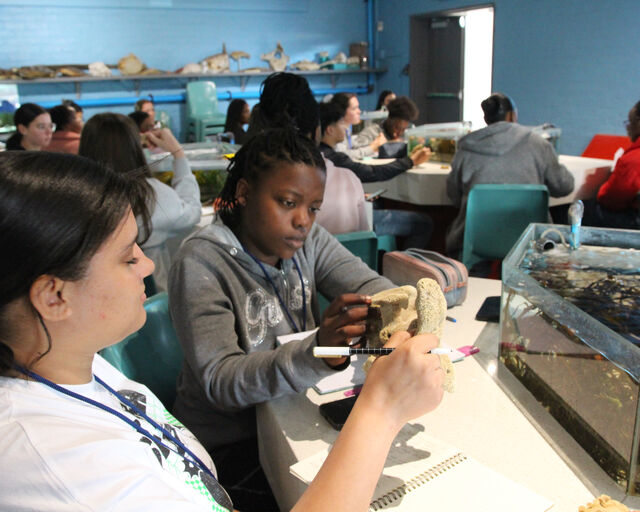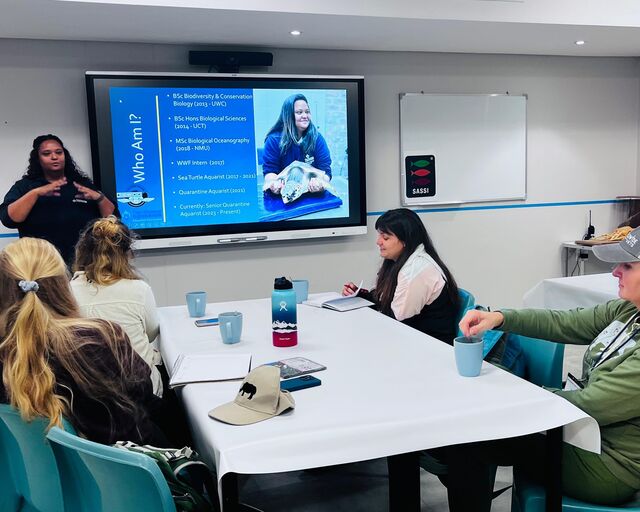Listening for turtles: The importance of acoustic tagging as a tool for conservation
Our talking turtles tell us tales of the sea
As many fans of the Two Oceans Aquarium Foundation’s Turtle Conservation Centre know, we make sure that some of our turtles can communicate with us even when they’ve been successfully rehabilitated and released back into the ocean.
While they can’t speak, they can have little acoustic tags carefully attached to their shells. These devices are giving off a sound that neither turtles nor humans can hear. But when a tagged turtle swims within 500 metres of an underwater receiver, which acts like a radio, the frequency of the sound is picked up and recorded and once the data is collated, we find out which turtles swam past which receivers. This is how they talk to us and tell us many things about their lives in the sea.
We’re part of an exciting national research project
Four of South Africa’s aquariums, together with a leading research institute, are working together on this project. Bayworld, the natural and cultural history museum in Gqeberha, which has had a turtle rescue program for at least four decades, is leading the project, supported by us, Durban’s South African Association for Marine Biological Research (SAAMBR, which also manages uShaka Sea World), the East London Aquarium and the national Acoustic Tracking Array Platform (ATAP). Thanks to ATAP, there are about 285 receivers in South African waters, according to Dr Taryn Murray, instrument scientist and manager of ATAP, which is a programme linked to the South African Institute for Aquatic Biodiversity.
“Each receiver is maintained by different scientists or organisations. Researchers can only get the data when the receivers are retrieved and the data downloaded and shared,” Talitha Noble-Trull, Turtle Conservation Centre Manager at the Two Oceans Aquarium Foundation, explains.
Using acoustic tags is like leaving a voice note on a cell phone to occasionally let your friends and family know how you’re doing, says Ruth Wright, project leader and aquarium curator in charge of sea turtle rehabilitation at Bayworld. “It’s like a loved one going away on a holiday and you’re so happy for them and excited for their amazing journey ahead, but you want them to let you know how they’re doing every now and then. That’s what the acoustic tag does.”
What are we trying to find out?
With SAAMBR, the Turtle Conservation Centre, Bayworld, and the East London Aquarium all acoustically tagging some of the turtles they release, the idea is to use any data received to build up a better understanding of turtles’ movement patterns along South Africa’s coastline. It also forms part of post-rehabilitation monitoring. Rehabilitating turtles, whether they’re hatchlings, sub-adults or adults, can take months and sometimes years. As Wright explains, it’s staff-intensive, time-intensive, cost-intensive, and highly specialised.
“We want to know, once the turtles are released, are we making a difference? Are we actually contributing to the survival and the conservation of these animals?” asks Wright.
From acoustically tagged turtles, the Turtle Conservation Centre has received two reports so far, says Noble-Trull, who adds that while some of the turtles released in De Hoop (a Marine Protected Area, or MPA, on the south coast) stayed around De Hoop for five months, one of the turtles went up to the Eastern Cape’s Wild Coast and then wandered back to De Hoop.
Murray says the data can give researchers insights into turtles’ retention along the coastline, telling us about whether or not they stay in the inshore areas and how important those inshore zones and MPAs are for them.
“Do they move between estuaries and the marine environment? Do they use estuaries as refuges? Do they move to different areas according to season? Do they undertake an annual migration? Do they move offshore during certain times of the year? Do they move in response to changes in water temperature? So many questions about a species’ movement ecology can be answered,” Murray says.
Why does the data matter?
Wright adds that the data could help to identify so-called turtle hotspots. For example, while turtles are typically solitary, they have been seen in small groups in places like De Hoop. Several turtles appear to be resident on the hard coral reefs of Sodwana in KwaZulu-Natal. This information can help scientists, conservationists, and the government to make decisions about the management and spatial planning of the ocean, MPAs and these endangered species. It also helps the organisations involved share fascinating stories about turtles’ lives with the public, raising awareness and aiding in their conservation.
It's too early yet to come to conclusions from the acoustically tagged turtles that have been returned to the ocean in South Africa, but Noble-Trull says the great thing is that the team on the national project is starting to get data.
Because, as Wright says, the more tagged turtles and receivers there are, the richer the data will be and the more we’ll all come to understand about turtles’ movements and needs and how best to protect them.
Related News
Sign up to our Newsletter
Receive monthly news, online courses and conservation programmes.

